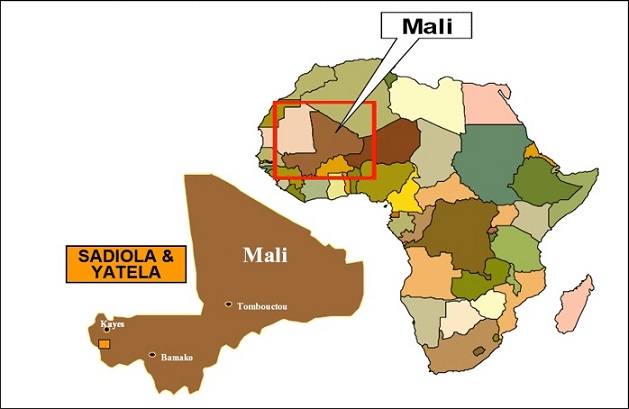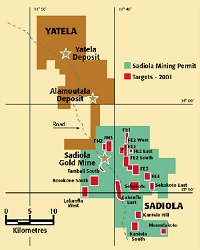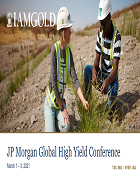Yatela Gold Mine, Mali

Location

 The Yatela Gold Mine is located 25 kilometres north of the Sadiola Gold Mine in southwest Mali, West Africa near the Senegal-Mali border, approximately 50 kilometres to the SSW of the town of Kayes, the regional capital. Kayes has a population of roughly 100,000 people. The city is located 510 kilometres northwest of the Mali capital Bamako.
The Yatela Gold Mine is located 25 kilometres north of the Sadiola Gold Mine in southwest Mali, West Africa near the Senegal-Mali border, approximately 50 kilometres to the SSW of the town of Kayes, the regional capital. Kayes has a population of roughly 100,000 people. The city is located 510 kilometres northwest of the Mali capital Bamako.History
Geology
The Yatela deposit is located within the northern, Malian portion of the Kenieba - Kedougou window. A full description of the regional geology can be found under the Sadiola Gold Mine Geology & Mineralization section of this website.
Mineralization

Gold and disseminated pyrite with associated albite, sericite and dolomite alteration occurs along a faulted contact between a carbonate sequence and a diorite, all unconformably overlain by Upper Proterozoic Seroukoto sandstones. Economic mineralization occurs in an unconsolidated ferruginous, sandy, locally clayey unit that lines the bottom of deep troughs (max 220 m) developed over the carbonates. The ore zone is overlain by a thick unit of angular blocks of Seroukoto sandstone and shale. This is covered by a fine sand unit and with interbedded layers of pisolithic gravel and laterite rubble. The final fill consists of stacked subhorizontal layers of pisolithic gravel grading into fine sands. The geometry of the lateritic layering indicates that deposition was concomitant with the deepening of the trough as deeper pisolithic layers show gradually increased sagging with depth. This is thought to result from karstic dissolution of mineralized carbonate and simultaneous infill of the depression. The ferruginous basal ore corresponds to the gold-enriched dissolution residue of the mineralized carbonate (Hanssen et al., 2004).
Mining

Processing

Source: http://www.iamgold.com/English/Operations/Operating-Mines/Yatela-Gold-Mine/Overview/default.aspx

|
- Design and supervision of construction of geotechnical and hydrological structures such as foundations, slopes, excavations, diversion ditch, and dams;
- Investigation of ground instabilities and recommending and designing mitigation measures
To purchase materials, goods, and services for all operations, maintenance, and support functions.
To provide safe and cost-effective survey services, by way of design, plans, and measurement data that communicate critical mining instructions to operators and development results to engineers.
To provide administrative support and ensure the efficient and effective functioning of the mill office and related activities.
The purpose of the Mine Road Supervisor is to ensure all site service roads are maintained year round.
The purpose of the Supervisor Mine is to supervise the mine crew and ensure production targets and schedules are met as forecast.
The Senior Mining Engineer takes part in the development of economic studies of mining projects (approach, prefeasibility, feasibility).
To ensure optimization of the Mill process is maintained through effective management and technical support to the Operations group as well as external support groups including Mine Technical Services and Mine Operations.
As a member of the Global Supply Chain (GSC), the analyst will utilize your abilities to provide actionable recommendations to the leaders of the organization.
This position is responsible to manage all maintenance activities including; safety, execution, personnel, budget, planning and continuous improvement.